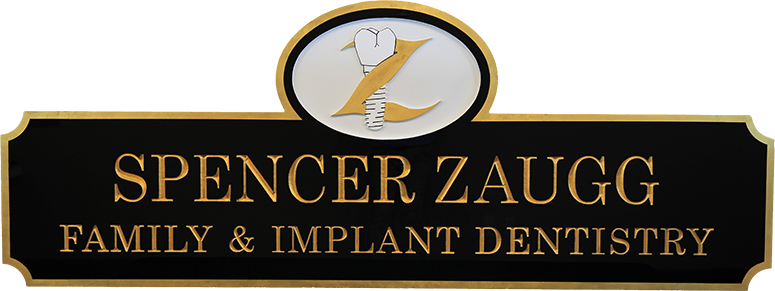What it is:
Periodontal disease is an infection of the tissues that support your teeth. If left untreated, it can cause tooth loss. Signs of gum disease are not always easy to see and can be painless. The earlier periodontal disease is caught, the easier it is to treat which is why it is important to visit our office on a regular basis to allow Dr. Zaugg and/or his dental hygienist to evaluate and take measurements of your teeth and gums.
THE THREE STAGES OF PERIODONTAL DISEASE
Gingivitis is the first stage of gum disease
- Milder and reversible form of periodontal disease that only affects the gums
- Gums feel tender and there is some bleeding when brushing and flossing
- Develops as toxins in plaque irritate gums, making them red, tender, swollen and likely to bleed easily
- Plaque (food debris and bacteria) is allowed to build up around the neck of the tooth and creates a sticky layer which causes a gum infection
- Usually can be eliminated by daily brushing, cleaning between the teeth, and regular dental cleanings
- If gingivitis is left untreated it can lead to periodontitis
Periodontitis is the second stage
- Occurs in susceptible patients when a long-term gum infection is not treated
- Plaque spreads to the tooth roots, causing an infection, which can damage the bones and fibers (ligaments) that hold teeth in place
- The gum line recedes as the gums pull away from the teeth
- Allows plaque to move toward the roots, supporting ligaments and bone
- Proper dental care and better home care can help prevent further damage
Advanced periodontitis is the final stage of gum disease
- Ligaments and bone holding teeth in place are destroyed so much that the tooth becomes loose
- Can still treat the disease, but in very advanced cases a loose tooth may need to be extracted or may fall out on its own
FACTORS WHICH SIGNIFICANTLY INCREASE THE RISK OF DEVELOPING PERIODONTITIS
-
Genetics
-
Smoking
-
Diabetes
-
Poor Oral Hygiene
-
Stress
-
Medications (certain anti-seizure, blood pressure, and immunosuppressant medications)
*To minimize your risk of future periodontal disease, you must be mindful of the risk factors stated above, Gingivitis is usually well managed by adopting excellent oral hygiene practices. Periodontitis is more difficult to manage.
Treatment:
Best prevention is good oral hygiene. Brushing twice daily and carefully cleaning between the teeth once daily is important. Regular dental check-ups in our office are essential. During the check-ups, we examine the gums and thoroughly clean to remove plaque and tartar deposits. If it is difficult for us to thoroughly remove the plaque and tartar, dude to deep pockets between teeth and gums, periodontal surgery may be needed.
NON-SURGICAL PERIODONTAL THERAPY
- Root cleaning (scaling and root planning) at the appropriate intervals to manage your risk for bone loss
- Antibacterial mouth rinses
- Oral antibiotics
- Customized home care instruction
- Smoking cessation counseling
- Surgical Periodontal Therapy
- Recontouring of gum and bone around affected teeth to allow better access for professional root cleaning and daily home care
SURGICAL PERIODONTAL THERAPY
Surgical Periodontal Therapy is the re-contouring of gum tissue and bone to decrease the risk of further periodontal disease. Surgical procedures are designed to either remove diseased gum tissue and bone for better cleaning access or to build missing tissue back to a healthier state.
Periodontal therapy to build back missing gum tissue and bone and often requires donor tissue. This tissue is usually obtained from another area of the person’s body, most often the palate or “roof”’ of their mouth. It can also be obtained from another donor person or animal where the tissues have been sterilized for safety and use.
PERIODONTAL SURGERY
- We access hard to reach areas that require the removal of tartar and plaque with surgery
- Tooth root is cleaned and smoothed
- Occasionally, the bone around the tooth is also smoothed to remove pockets
- The gums are then sutured back into place or into a new position that will be easier to clean at home
*If a patient requires surgical therapy intervention, but chooses a non-surgical option, they need to understand that inappropriate periodontal therapies do not manage the disease properly and recognize the risk of further periodontal infection with tissue, bone and ultimately tooth loss.


